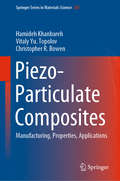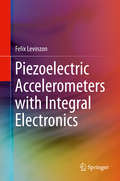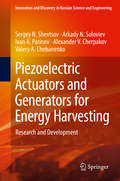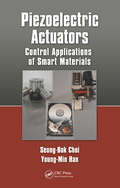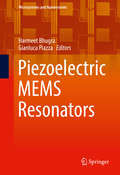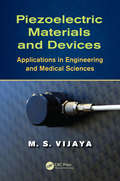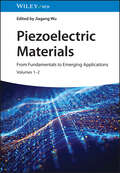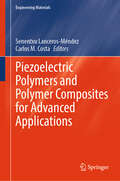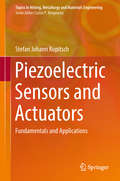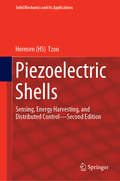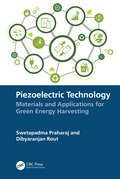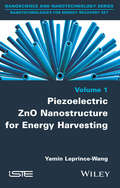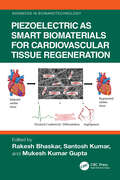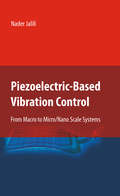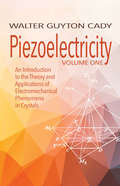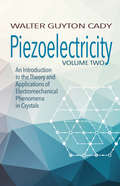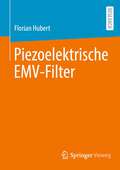- Table View
- List View
Piezo-Particulate Composites: Manufacturing, Properties, Applications (Springer Series in Materials Science #283)
by Christopher R. Bowen Vitaly Yu. Topolov Hamideh KhanbarehThis book provides an overview of the current state of the art in novel piezo-composites based on ferroelectrics. Covering aspects ranging from theoretical materials simulation and manufacturing and characterization methods, to the application and performance of these materials, it focuses on the optimization of the material parameters.Presenting the latest findings on modern composites and highlighting the applications of piezoelectric materials for sensors, transducers and hydro-acoustics, the book addresses an important gap in the physics of active dielectrics and materials science and describes new trends in the research on ferroelectric composites.
Piezoelectric Accelerometers with Integral Electronics
by Felix LevinzonThis book provides an invaluable reference to Piezoelectric Accelerometers with Integral Electronics (IEPE). It describes the design and performance parameters of IEPE accelerometers and their key elements, PE transducers and FET-input amplifiers. Coverage includes recently designed, low-noise and high temperature IEPE accelerometers. Readers will benefit from the detailed noise analysis of the IEPE accelerometer, which enables estimation of its noise floor and noise limits. Other topics useful for designers of low-noise, high temperature silicon-based electronics include noise analysis of FET amplifiers, experimental investigation and comparison of low-frequency noise in different JFETs and MOSFETs, and ultra-low-noise JFETs (at level of 0. 6 nV/√Hz). The discussion also includes ultra-low-noise (at level of 3 ng/√Hz) seismic IEPE accelerometers and high temperature (up to 175 C) triaxial and single axis miniature IEPE accelerometers, along with key factors for their design. * Provides a comprehensive reference to the design and performance of IEPE accelerometers, including low-noise and high temperature IEPE sensors; * Includes noise analysis of the IEPE accelerometer, which enables estimation of the its noise floor and noise limits; * Describes recently design of ultra-low-noise (at level of 3 ng/√Hz) IEPE seismic accelerometers and high temperature (up to 175 C) triaxial and single axis miniature IEPE accelerometers; * Compares low-frequency noise in different JFETs and MOSFETs including measurement results of ultra-low-noise (at level of 0. 6 nV/√Hz) JFET; * Presents key factors for design of low-noise and high temperature IEPE accelerometer and their electronics.
Piezoelectric Actuators and Generators for Energy Harvesting: Research And Development (Innovation And Discovery In Russian Science And Engineering Ser.)
by Ivan A. Parinov Sergey N. Shevtsov Arkady N. Soloviev Alexander V. Cherpakov Valery A. ChebanenkoThis book presents new approaches to R&D of piezoelectric actuators and generators of different types based on established, original constructions and contemporary research into framework of theoretical, experimental, and numerical methods of physics, mechanics, and materials science. Improved technical solutions incorporated into the devices demonstrate high output values of voltage and power, allowing application of the goods in various areas of energy harvesting. The book is divided into seven chapters, each presenting main results of the chapter, along with a brief exposition of novel findings from around the world proving context for the author’s results. It presents particular results of the Soviet and Russian schools of Mechanics and Material Sciences not previously available outside of Russia.
Piezoelectric Actuators: Control Applications of Smart Materials
by Seung-Bok Choi Young-Min HanCurrently, many smart materials exhibit one or multifunctional capabilities that are being effectively exploited in various engineering applications, but these are only a hint of what is possible. Newer classes of smart materials are beginning to display the capacity for self-repair, self-diagnosis, self-multiplication, and self-degradation. Ultima
Piezoelectric Bending Transducers: The Physics of Their Static and Dynamic Behaviour A Textbook About Indispensable Actuators in Microtechnology, Mechatronics and Medical Technology
by Rüdiger G. BallasThe wide range of industrial applications for piezoelectric bending transducers as actuators and high-precision positioning systems requires their performance to be adapted to the respective task. This presupposes that it is already possible to predict the static and dynamic behaviour of such actuator structures in the respective application during the design and development phase. The geometric dimensions of the individual active and passive layers, their sequence in the layer system and their elasto- and electromechanical properties are key factors here. This book focuses on the analytical description of the static and dynamic behaviour of piezoelectric multilayer bending transducers. It is intended to provide students of natural sciences and engineering as well as engineers and scientists in practice with a solid engineering tool for the design of piezoceramic bending transducers. The benefits of the analytical description obtained are demonstrated based on real measurements on a monomorph in multilayer technology. The requirements for understanding the material are limited to basic knowledge of one- and multidimensional analysis as well as elementary Newtonian mechanics, technical mechanics and electricity.
Piezoelectric Ceramic Resonators
by Jiří Erhart Petr Půlpán Martin PustkaThis book helps the reader to understand the specific properties of piezoelectric ceramic resonators. It provides their theoretical description by immitance and equivalent circuit method. The nummerical modelling described is accompanied by examples of properties measured experimentally. Piezoelectric ceramic transformers are also covered, followed by a series of solved and unsolved problems prepared specially for students.
Piezoelectric Energy Harvesting
by Alper Erturk Daniel J. InmanThe transformation of vibrations into electric energy through the use of piezoelectric devices is an exciting and rapidly developing area of research with a widening range of applications constantly materialising. With Piezoelectric Energy Harvesting, world-leading researchers provide a timely and comprehensive coverage of the electromechanical modelling and applications of piezoelectric energy harvesters. They present principal modelling approaches, synthesizing fundamental material related to mechanical, aerospace, civil, electrical and materials engineering disciplines for vibration-based energy harvesting using piezoelectric transduction.Piezoelectric Energy Harvesting provides the first comprehensive treatment of distributed-parameter electromechanical modelling for piezoelectric energy harvesting with extensive case studies including experimental validations, and is the first book to address modelling of various forms of excitation in piezoelectric energy harvesting, ranging from airflow excitation to moving loads, thus ensuring its relevance to engineers in fields as disparate as aerospace engineering and civil engineering.Coverage includes:Analytical and approximate analytical distributed-parameter electromechanical models with illustrative theoretical case studies as well as extensive experimental validationsSeveral problems of piezoelectric energy harvesting ranging from simple harmonic excitation to random vibrations Details of introducing and modelling piezoelectric coupling for various problemsModelling and exploiting nonlinear dynamics for performance enhancement, supported with experimental verificationsApplications ranging from moving load excitation of slender bridges to airflow excitation of aeroelastic sections A review of standard nonlinear energy harvesting circuits with modelling aspects.
Piezoelectric MEMS Resonators
by Harmeet Bhugra Gianluca PiazzaThis book introduces piezoelectric microelectromechanical (pMEMS) resonators to a broad audience by reviewing design techniques including use of finite element modeling, testing and qualification of resonators, and fabrication and large scale manufacturing techniques to help inspire future research and entrepreneurial activities in pMEMS. The authors discuss the most exciting developments in the area of materials and devices for the making of piezoelectric MEMS resonators, and offer direct examples of the technical challenges that need to be overcome in order to commercialize these types of devices. Some of the topics covered include: Widely-used piezoelectric materials, as well as materials in which there is emerging interest Principle of operation and design approaches for the making of flexural, contour-mode, thickness-mode, and shear-mode piezoelectric resonators, and examples of practical implementation of these devices Large scale manufacturing approaches, with a focus on the practical aspects associated with testing and qualification Examples of commercialization paths for piezoelectric MEMS resonators in the timing and the filter markets . . . and more! The authors present industry and academic perspectives, making this book ideal for engineers, graduate students, and researchers.
Piezoelectric Materials and Devices: Applications in Engineering and Medical Sciences
by M. S. VijayaStarting from the fundamentals, this book provides a concise yet complete treatment of piezoelectric materials, an important class of smart materials which are useful as both actuators and sensors. Including case studies, the text introduces different types of dielectric materials, describes the preparation and properties of various piezoelectric materials used in device applications, and presents various engineering and medical applications of piezoelectric materials. It also discusses in detail the design and virtual prototyping of piezoelectric devices using commercially available software tools like ANSYS and PAFEC.
Piezoelectric Materials: Applications in SHM, Energy Harvesting and Biomechanics (ANE/Athena Books)
by Suresh Bhalla Sumedha Moharana Visalakshi Talakokula Naveet KaurPiezoelectric materials are attracting significant research efforts and resources worldwide. The major thrust areas include structural health monitoring, bio-mechanics, bio-medicine and energy harvesting. Engineering and technological applications of this smart material warrants multi-dimensional theoretical and experimental knowledge and expertise in fields of mechanics, instrumentation, digital electronics and information technology, over and above the specific domain knowledge. This book presents, from theory to practice, the application of piezoelectric smart materials in engineering domains such as structural health monitoring (SHM), bio-mechanics, bio-medical engineering and energy harvesting.
Piezoelectric Materials: From Fundamentals to Emerging Applications
by Jiagang WuPiezoelectric Materials Analyze the foundational materials of the electronics industry In recent years piezoelectric materials have become one of the world’s most important classes of functional materials. Their ability to convert between mechanical and electrical energy makes them indispensable for sensors, transducers, actuators, catalysts, and many other foundational electronic devices. As electronics industries expand at unprecedented rates, the range of applications for piezoelectric materials continues to grow. Piezoelectric Materials offers a comprehensive overview of this group of materials, its key properties, and its applications. Beginning with the fundamental science of piezoelectric phenomena, it then analyzes different the numerous different classes of piezoelectric materials and their current and future industrial functions. The result is essential for engineers and materials scientists working in any number of areas. Piezoelectric Materials readers will also find: Analysis of materials types include lead-based and lead-free piezoelectric materials, textured piezoceramics, piezoelectric thin films, and many moreDetailed discussion of applications including dielectric energy storage and biomedical technologyAuthorship by a leading researcher of piezoelectric materials Piezoelectric Materials is ideal for materials scientists, electronic engineers, polymer chemists, solid state chemists, and any other researchers or professionals working with these key materials.
Piezoelectric Polymers and Polymer Composites for Advanced Applications (Engineering Materials)
by Senentxu Lanceros‐Méndez Carlos M. CostaThis book provides a comprehensive exploration of piezoelectric polymers and composites, detailing their structures, fabrication, and applications across fields such as biomedical, electronic, and environmental science. Addressing the demands of Industry 4.0 and the Internet of Things, it delves into the most relevant materials like Polyvinylidene Fluoride and Poly-l-Lactic Acid, highlighting their properties, functionality, and versatility in energy harvesting, sensing, actuation, and biomedical applications, among others. Each chapter introduces fundamental concepts, recent advancements, and future directions, serving as both a reference for current knowledge and a guide for ongoing research in piezoelectric materials science.
Piezoelectric Sensors (Springer Series on Chemical Sensors and Biosensors #18)
by Peter LieberzeitThis book provides a comprehensive overview of piezoelectric sensor devices and instrumentation and their use for chemical and biochemical analysis. Sensors relying on established transducers, such as the quartz crystal microbalance (QCM) and the surface acoustic wave resonator (SAW) are covered, and novel devices like surface transverse wave (STW) resonators, film bulk acoustic resonators (FBAR) as well as non-piezoelectric devices with mass-sensitive properties are presented. As their name implies, such devices respond directly to mass changes on their surfaces and thus address the most fundamental quality of any analytes. First, the book presents the fundamentals of new measuring strategies with these devices. Then, it introduces a variety of chemo- and biosensing application scenarios of these devices. In addition, the book covers both the state-of-the-art of academic research and prospects concerning the commercialization of these sensors. Given its scope, the book is of interest to academics, specialists in industry, and advanced students in the areas of analytical chemistry, rapid analysis, and sensor technology, giving them the unique possibility to familiarize themselves with this chemical sensing strategy. Readers will benefit from the coverage of both cutting-edge research results and applications that help bridge the gap between academia and industry.
Piezoelectric Sensors and Actuators: Fundamentals and Applications (Topics in Mining, Metallurgy and Materials Engineering)
by Stefan Johann RupitschThis book introduces physical effects and fundamentals of piezoelectric sensors and actuators. It gives a comprehensive overview of piezoelectric materials such as quartz crystals and polycrystalline ceramic materials. Different modeling approaches and methods to precisely predict the behavior of piezoelectric devices are described. Furthermore, a simulation-based approach is detailed which enables the reliable characterization of sensor and actuator materials. One focus of the book lies on piezoelectric ultrasonic transducers. An optical approach is presented that allows the quantitative determination of the resulting sound fields. The book also deals with various applications of piezoelectric sensors and actuators. In particular, the studied application areas are · process measurement technology, · ultrasonic imaging, · piezoelectric positioning systems and · piezoelectric motors. The book addresses students, academic as well as industrial reseachers and development engineers who are concerned with piezoelectric sensors and actuators.
Piezoelectric Shells: Sensing, Energy Harvesting, and Distributed Control—Second Edition (Solid Mechanics and Its Applications #247)
by Hornsen Hs TzouThis book offers an introduction to piezoelectric shells and distributed sensing, energy harvesting and control applications. It familiarizes readers with a generic approach of piezoelectric shells and fundamental electromechanics of distributed piezoelectric sensors, energy harvesters and actuators applied to shell structures. The book is divided into two major parts, the first of which focuses on piezoelectric shell continua, while the second examines distributing sensing, energy harvesting and control of elastic continua, e.g., shells and plates.The exploitation of new, advanced multifunctional smart structures and structronic systems has been one of the mainstream research and development activities over the years. In the search for innovative structronics technologies, piezoelectric materials have proved to be very versatile in both sensor and actuator applications. Consequently, the piezoelectric technology has been applied to a broad range of practical applications, from small-scale nano- and micro-sensors/actuators to large-scale airplane and space structures and systems.The book provides practicing engineers and researchers with an introduction to advanced piezoelectric shell theories and distributed sensor/energy harvester/actuator technologies in the context of structural identification, energy harvesting and precision control. The book can also be used as a textbook for graduate students. This second edition contains substantial new materials, especially energy harvesting and experimental components, and has been updated and corrected for a new generation of readers.
Piezoelectric Technology: Materials and Applications for Green Energy Harvesting
by Dibyaranjan Rout Swetapadma PraharajThis book explains the state-of-the-art green piezoelectric energy harvesting (PEH) technology. It highlights different aspects of PEH, starting right from the materials, their synthesis, and characterization techniques to applications. Various types of materials, including ceramics, polymers, composites, and bio-inspired compounds in nano, micro, and meso scale and their recent advancements are captured in detail with special focus on lead-free systems. Different challenges and issues faced while designing a PEH are also included. Features: Guides on how to harvest piezoelectric energy in a sustainable manner. Describes related figures of merit for piezoelectric energy harvesting. Covers synthesis of piezoelectric materials in the form of bulk, single crystal, nano, and thin/thick film. Includes pertinent advanced characterization techniques. Reviews piezo-energy harvesting devices and structures. This book is aimed at researchers, professionals, and graduate students in electrical engineering, materials, and energy.
Piezoelectric ZnO Nanostructure for Energy Harvesting, Volume 1
by Yamin Leprince-WangOver the past decade, ZnO as an important II-VI semiconductor has attracted much attention within the scientific community over the world owing to its numerous unique and prosperous properties. This material, considered as a "future material", especially in nanostructural format, has aroused many interesting research works due to its large range of applications in electronics, photonics, acoustics, energy and sensing. The bio-compatibility, piezoelectricity & low cost fabrication make ZnO nanostructure a very promising material for energy harvesting.
Piezoelectric as Smart Biomaterials for Cardiovascular Tissue Regeneration (Advances in Bionanotechnology)
by Santosh Kumar Mukesh Kumar Gupta Rakesh BhaskarThis book covers the range of piezoelectric biomaterials having the potential for applications in cardiac tissue engineering (CTE) and addresses the recent developments, trends, and challenges of piezoelectric biomaterials for targeted cardiovascular disease (CVD) therapies.It covers the applications of engineered piezoelectric biomaterials including recent developments in piezoelectric biomaterials and their possible impact on treating CVDs and CTE. Main points discussed in the book are: Focusses on piezoelectric biomaterials for the treatment of cardiovascular diseases Covers imitation of mechanoelectrical transduction system as in cardiac tissues Comprehensively covers functional piezoelectric biomaterials preparation and applications Reviews engineered piezoelectric biomaterials applications for better health care Discusses elastomer actuators for heart tissues This book is aimed at graduate students and researchers in tissue engineering, regenerative medicine, biophysics, and biomaterials.
Piezoelectric-Based Vibration Control
by Nader Jalili"Piezoelectric-Based Vibration-control Systems: Applications in Micro/Nano Sensors and Actuators" covers: Fundamental concepts in smart (active) materials including piezoelectric and piezoceramics, magnetostrictive, shape-memory materials, and electro/magneto-rheological fluids; Physical principles and constitutive models of piezoelectric materials; Piezoelectric sensors and actuators; Fundamental concepts in mechanical vibration analysis and control with emphasis on distributed-parameters and vibration-control systems; and Recent advances in piezoelectric-based microelectromechanical and nanoelectromechanical systems design and implementation.
Piezoelectricity: An Introduction to the Theory and Applications of Electromechanical Phenomena in Crystals (Dover Books on Electrical Engineering)
by Walter Guyton CadyAfter World War II, piezoelectric phenomena became extremely important in communications media and were the subject of extensive scientific investigation. This two-volume treatise, written by a major contributor to the field, offers a complete, systematic survey of the physical properties and the practical applications of piezoelectric crystals.
Piezoelectricity: An Introduction to the Theory and Applications of Electromechanical Phenomena in Crystals (Dover Books on Electrical Engineering)
by Walter Guyton CadyAfter World War II, piezoelectric phenomena became extremely important in communications media and were the subject of extensive scientific investigation. This two-volume treatise, written by a major contributor to the field, offers a complete, systematic survey of the physical properties and the practical applications of piezoelectric crystals.
Piezoelektrische Biegewandler: Zur Physik des statischen und dynamischen Verhaltens
by Rüdiger G. BallasDie vielfältigen industriellen Einsatzmöglichkeiten von piezoelektrischen Biegewandlern als Aktoren und hochpräzise Positioniersysteme erfordern eine an die jeweilige Aufgabe angepasste Leistungsfähigkeit. Dies setzt voraus, dass bereits in der Entwurfs- und Entwicklungsphase das statische und dynamische Verhalten solcher Aktor-Strukturen in der jeweiligen Anwendung vorhergesagt werden kann. Die geometrischen Abmessungen der einzelnen aktiven und passiven Schichten, ihre Abfolge im Schichtsystem und ihre elasto- und elektromechanischen Eigenschaften sind dabei Schlüsselfaktoren. Dieses Buch konzentriert sich auf die analytische Beschreibung des statischen und dynamischen Verhaltens von piezoelektrischen Mehrschicht-Biegewandlern. Es soll Studierenden der Natur- und Ingenieurwissenschaften, insbesondere der Physik, der Mikro- und Feinwerktechnik, der Mess- und Sensortechnik, der Mechatronik und Automatisierungstechnik sowie Ingenieur:innen und Wissenschaftler:innen in der Praxis ein solides technisches Werkzeug für den Entwurf von piezokeramischen Biegewandlern an die Hand geben. Die Vorteile der analytischen Beschreibung werden anhand realer Messungen an einem Monomorph in Multilayer-Technologie demonstriert. Die Anforderungen an das Verständnis des Materials beschränken sich auf Grundkenntnisse der ein- und mehrdimensionalen Analysis sowie der elementaren Newtonschen Mechanik, der technischen Mechanik und der Elektrizitätslehre.
Piezoelektrische EMV-Filter
by Florian HubertIm vorliegenden Buch wird eine neue EMV-Filtermaßnahme eingeführt, die auf dem piezoelektrischen Effekt basiert. Piezoelektrische EMV-Filter (PEF) erzeugen bei ihren Resonanzfrequenzen einen niederimpedanten Ausbreitungspfad für leitungsgebundene elektromagnetische Störungen. Dies ermöglicht eine Unterdrückung diskreter Störspitzen. Jenseits der Resonanzen verhalten sich PEF kapazitiv. PEF können daher nicht nur reguläre Funkentstörkondensatoren, wie z.B. Y-Kondensatoren, ersetzen, sondern ermöglichen zusätzlich eine selektive Dämpfung bei dezidierten Störfrequenzen. Es wird gezeigt, dass sich durch Verwendung eines PEF ein kompakterer EMV-Filter realisieren lässt. Hiermit werden Abmessungen, Gewicht und letztendlich die Kosten von EMV-Maßnahmen wesentlich reduziert.
Piezoresistive Effect of p-Type Single Crystalline 3C-SiC
by Hoang-Phuong PhanThis book addresses the piezoresistance in p-type 3C-SiC, which it investigates using experimental characterization and theoretical analysis. The gauge factor, the piezoresistive coefficients in two-terminal and four-terminal resistors, the comparison between single crystalline and nanocrystalline SiC, along with the temperature dependence of the piezoresistive effect in p-type 3C-SiC are also discussed. Silicon carbide (SiC) is an excellent material for electronic devices operating at high temperatures, thanks to its large energy band gap, superior mechanical properties and extreme chemical inertness. Among the numerous polytypes of SiC, the cubic single crystal, which is also well known as 3C-SiC, is the most promising platform for microelectromechanical (MEMS) applications, as it can be epitaxially grown on an Si substrate with diameters of up to several hundred millimeters. This feature makes 3C-SiC compatible with the conventional Si-based micro/nano processing and also cuts down the cost of SiC wafers. The investigation into the piezoresistive effect in 3C-SiC is of significant interest for the development of mechanical transducers such as pressure sensors and strain sensors used for controlling combustion and deep well drilling. Although a number of studies have focused on the piezoresistive effect in n-type 3C-SiC, 4H-SiC and 6H-SiC, comparatively little attention has been paid to piezoresistance in p-type 3C-SiC. In addition, the book investigates the piezoresistive effect of top-down fabricated SiC nanowires, revealing a high degree of sensitivity in nanowires employing an innovative nano strain-amplifier. The large gauge factors of the p-type 3C-SiC at both room temperature and high temperatures found here indicate that this polytype could be suitable for the development of mechanical sensing devices operating in harsh environments with high temperatures.
Piezoresistor Design and Applications
by Joseph C. Doll Beth L. PruittPiezoresistor Design and Applications provides an overview of these MEMS devices and related physics. The text demonstrates how MEMS allows miniaturization and integration of sensing as well as efficient packaging and signal conditioning. This text for engineers working in MEMS design describes the piezoresistive phenomenon and optimization in several applications. Includes detailed discussion of such topics as; coupled models of mechanics, materials and electronic behavior in a variety of common geometric implementations including strain gages, beam bending, and membrane loading. The text concludes with an up-to-date discussion of the need for integrated MEMS design and opportunities to leverage new materials, processes and MEMS technology. Piezoresistor Design and Applications is an ideal book for design engineers, process engineers and researchers.
